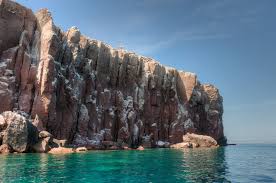
About the site
The Islands and Protected Areas of the Gulf of California in north-eastern Mexico is a serial property comprising 244 islands, islets and coastal areas. Spread across 18,37,194 hectares, one quarter of the area is terrestrial and the remainder marine.
Once dubbed the ‘Aquarium of the World’, the Gulf is known for its biodiversity, containing 39% of the world’s marine mammal species and a third of the world’s marine cetacean species. Today, however, sharp decline in the numbers of certain marine species is clouding the Gulf’s prestigious tag as the Aquarium of the World. Despite this, the biodiversity here is rich and diverse. It is home to 695 bascular plant species, and 891 sicculents in the region, including some of the world’s tallest cacti which are over 25m in height. When it comes to birds, migratory birds found here. Some of the small islands of the Gulf of California host a majority of the global population of heermann’s gulls, blue-footed booby, and black storm petrel. Meanwhile, one can find sea lions thronging the coast as well as vaquitos, totoabas, grey whales and marine turtles such as the leatherback, olive ridley and loggerhead, swimming in the open ocean.
The rugged islands as well as the coast, most of which are part of the Sonoran Desert, of the Gulf of California are as striking as the pristine turquoise waters. The islands and islets in the region are mostly of volcanic origin.
In danger
In June 2019, the UNESCO World Heritage Committee inscribed The Islands and Protected Areas of the Gulf of California on the List of World Heritage in Danger. This was due to the concern of the imminent extinction of the vaquita, a porpoise endemic to the Gulf of California. The vaquita is one of the characteristic features that made UNESCO include The Islands and Protected Areas of the Gulf of California in the World Heritage list.
According to the International Union for Conservation of Nature, the vaquita is the most endangered marine mammal species in the world. When it was scientifically discovered and given a formal description in 1958, the vaquita was already not very abundant. It was difficult to spot and observe the species properly. Its status however has continued to deteriorate since then, due to the use of mail nets in the illegal fishing of totoaba, another species endemic to the Gulf of California. The fishing of totoaba was banned in 1975, however, due to the high price the dried totoaba swim bladder (used in traditional medicine) commands in China, illegal fishing continues to date. Since the totoabas are large in size, the nets used to capture them are capable of trapping the voquitas as well. And once a vaquita is caught, it drowns within minutes.
While Mexico has taken measures such as creating a refuge for the surviving vaquitas and prompting alternatives to gillnets, which cause death by asphyxiation of marine mammals, the number of the species continues to drop. If conservation efforts are not improved, the species may soon becomes extinct, and the Gulf of California will not be the same.
Picture Credit : Google




